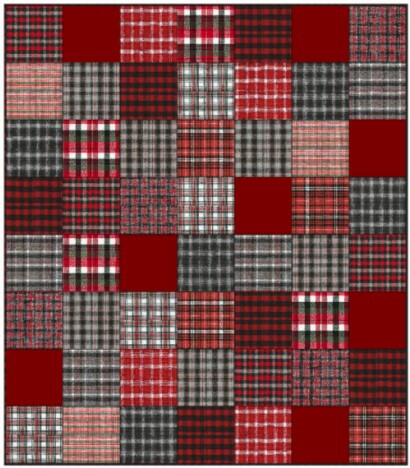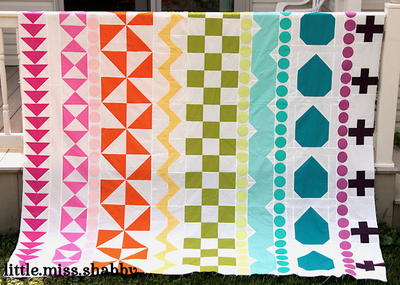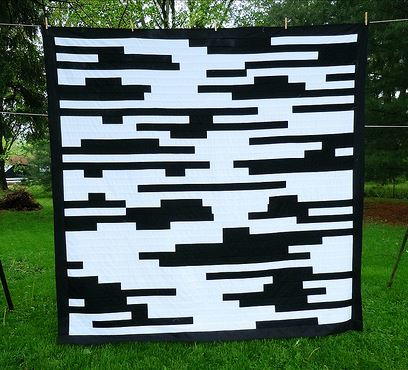Lumberjack Flannel Quilt Pattern

"The Lumberjack Flannel Quilt Pattern is an easy project for a beginning quilter. There’s nothing complicated about the pattern!! All directions for this Lumberjack quilt are included below. The Lumberjack quilt is super cozy! At a finished size of 66 ½” x 76”, the all-flannel Lumberjack quilt provides that extra layer of warmth and softness on those chilly nights! Lakegirlquilts is located in northern Wisconsin, an area rich in lumbering history. One of the oldest log cabins on our lake was originally a lumber camp over 100 years ago! The flannel fabrics of this quilt reminds me of the type of shirts a lumberjack would wear to keep warm in the woods!" - Bonnie Osness
Find more pretty patterns from our friend Bonnie over at her blog, Lakegirlquilts.
Click Here to Download the PDF Pattern!
Join Our 100,000+ Fans And Sign Up to Receive Your FREE eNewsletter!
General Sewing Directions
- The directions for this Lumberjack quilt are for rotary cutting, machine piecing, machine quilting -- the binding is hand stitched to the quilt back.
- Accurate cutting and sewing enhances your final product. Pin your pieces together before sewing them to ensure proper seam alignment.
- Use a ¼” seam allowance. I recommend using a special presser foot with a ¼” guide if you have one for your machine. This will help you get uniform seams, and matching corners!
- Follow the directions described below as you press open the seams. Each individual row is pressed in the opposite direction of the previous row to eliminate bulk and help seams to lay flat. Rows sewn together are then all pressed in one direction for a uniform look.
- The finished quilt measures 66 ½” x 76”.
Fabric Requirements
The inspiration for this quilt started with a wonderful 42-piece 10” layer cake bundle which I purchased at a quilting event last year. This fabric had me at Hello! I can’t resist red, black, and gray flannel prints! I added to the variety of ten fabrics found in the bundle by including a couple of flannel fabrics I had in my stash.
Flannel Fabric for Quilt Top Squares: Need 56 total 10” squares. I suggest using at least 10-12 different prints, you can cut 4 squares out of 3/8 yard of fabric. The total fabric needed is about 5 yards.
Backing Flannel Fabric: 2 yards of 108” wide fabric or 4 yards 44” fabric.
Binding Fabric: 1/2-yard total
Batting: You'll need a twin size 72” x 90” thin cotton batting to make this quilt.
Trim one side of the batting to 82”, so you have a finished 72” x 82” rectangle of batting. I always extend the batting 2-3” beyond each side of the finished quilt top to allow for stretching of the quilt top that happens when machine quilting.
Cutting Directions
Binding: Cut seven 2 ½” x 44” strips, trim the ends of each strip at opposing 45-degree angles.
Batting: Cut a 72” x 82” rectangles.
Assemble the Quilt Top
Now that you have all your 10” squares cut; you want to plan how they'll be arranged to make up the quilt top. The layout will be 7 squares across and 8 squares down. I take a picture of this so I have the layout in case I mess up when sewing the rows together! Then I carefully stack each row.

Sew the Rows
The quilt top has 8 rows. Begin stitching squares together (right sides facing) to complete each row. I always have to make sure to sew the squares together in the order I had arranged them, referring to my picture if I mess up.
Press the Blocks and Rows
I wait to press the 7-block rows until I have each of the 8 rows sewn together. Be careful to just “press” and NOT “iron” the seams in a back-and-forth motion.
Begin by pressing the seams of the first row all in one direction. Press the seams of the second row in the opposite direction. Continue to rotate the pressing direction of each row until you have the seams of all rows pressed. Think...odd rows 1, 3, 5, etc. press the seams to the right. Even rows 2, 4, 6, etc. press the seams to the left.
This method of pressing distributes the bulk, which will make you happy when machine quilting your project! Bulky seams can lead to bumpy quilting patterns, broken thread, and overall unevenness of your machine-quilted quilt top.
Now that you have the pieced rows pressed, sew them together! Rows all get pressed in one direction, either towards the top or towards the bottom.
Finishing the Quilt
Now that you have your quilt top sewn together, it’s time to finish it! Some people call the completed quilt top a flimsy, and I really like this term. It’s a flimsy because you haven’t yet added the 3 B’s to your quilt – batting, backing, and binding!
Layering the Top, Batting, and Back
I refer to layering the quilt as “sandwiching”. You need to sandwich the top and back with the batting in the middle.
On a large floor area or with two tables pushed together, use masking or painter’s tape to tape down the backing fabric. As you tape the back to the surface, you’ll want to make sure the fabric is smooth, without wrinkles. Make sure the back it taped taut, but not stretched. Also, make sure the right side of the fabric is facing down!
Lay the batting on top of the taped-down quilt back, and move your hands across it to smooth it all over. This will get rid of any wrinkles in the batting, and help to adhere it to the backing fabric.
Once you have the batting placed on top of the quilt back, center the top of the quilt (the flimsy!) over the two bottom layers. Right side facing up, of course! The two bottom layers of the quilt (the back and the batting) should extend about 2-3” all around the outside edges of the quilt top.
Move your hands across the quilt top to smooth it all over, and help remove any wrinkles. This will also help adhere the quilt top to the batting a little bit. Once you have the top of the quilt all smoothed out, either use basting spray or use 1 ½” stainless pins to baste your quilt layers together. You’ll want to start basting on one side of the quilt, and work your way across, or work from top to bottom. If pinning, you should place a pin about every 4 inches or so.
"Quilting” the Quilt
I chose a straight machine quilting stitch to permanently join all three layers of the Lumberjack quilt together.
I used a plaid pattern in my straight stitching. Use 2” and 1” painter’s tape to accomplish this quilting design. I started my machine quilting by stitching ½ inch from each vertical and horizontal seam.
Then, I measured 2 ½” from the seam (using my plastic ruler to measure evenly), and taped along this measurement with the wide tape.
From the wide tape, I measured another 2” and taped the 1” tape in this location. As you tape, remove pins that are in the way of the tape. Also, remove pins as you stitch near them.
Then, I stitched along all 4 sides of the tape. I proceeded in this manner until I had all the vertical and horizontal lines stitched. This is a really easy way to machine quilt your layers!
Binding the Quilt
When you’ve finished quilting the layers together, it’s time to bind the edges of your quilt! This could be a lesson in itself!! I’ll do my best to describe the binding process below, but if you’re confused by my directions there are lots of videos on the Internet that will demonstrate the process for you.
Prepare Binding Strip
Take your 2 ½” binding strips that you previously cut and prepare to sew them together. To do this, fold the strip in half. Using your ruler, find the 45-degree line and lay is along the bottom of the folded strip. Now, you can cut a 45-degree angle through both layers. When you open up the strip each end will have the angle facing in the opposite direction.
Align two strips together perpendicularly along the 45 degree ends. Who ever thought you’d use those 4th grade geometry skills again, lol! Pin the ends and sew them together.
Press the Binding
Press the seams open. You’ll need a finished strip that is about 56” to 60” in total length.
Then, fold the binding strip in half (wrong sides together), and press.
Sew the Binding Strip to the Quilt
Begin to sew the raw edge of the binding to the quilt by pinning it along one side. Be careful to sew the raw edge of the binding strip to the quilt, not the folded edge!
I usually start sewing the binding strip in the middle of the quilt side that I’m starting with. Start sewing about 5” in from the end of the binding strip, leaving a hanging “tail” on the binding. You’ll sew this to the end of the binding strip when you finish sewing all along the sides of the quilt.
Stop sewing on the first side ¼” from the corner, use a pin to mark this location and sew right up to it. Backstitch a bit, and cut your thread but DON’T cut the binding strip.
Making the Mitered Corner
Now, remove the quilt and binding strip from your machine and fold the binding strip straight up so it’s perpendicular from the side you were just sewing on.
Fold the binding strip back down on itself and match it to the edge of the quilt you just sewed it to, and the next edge of the quilt you’re about to sew it to. Pin this fold in place, and pin the binding strip to this edge of the quilt and continue to sew it, again stopping ¼” from the next corner and repeating the folding process described above.
Continue in this manner until you are on the last side of the quilt, the side you started on.
Connecting the Ends of the Binding
Stop stitching about 4” from where you started. Backstitch and cut the thread (but not the binding strip, not yet!), remove the quilt and binding strip from the machine.
You now have two “tails” of the binding strip, one from where you started stitching it to the quilt and one from where you just stopped. You’ll need to join these tails together so that you have a continuous binding strip to finish sewing down to the quilt. This can be tricky!
I don’t worry now about cutting 45-degree angles on each end of the binding strip to sew it together to make a continuous strip. If you can master this technique, my hat is off to you!! What I do is measure how much more binding strip I’ll need to finish sewing it to the edge of the quilt. I then cut a straight line along each end of the binding strip, adding ¼” to each end so I can sew the ends together with a ¼” seam (right sides together). Continue to sew the now continuous binding strip to the quilt.
Trim the Batting and Back
Trim the batting and quilt back to ¼” from the edge of the quilt top. I use a ruler and a rotary cutter to accomplish this task. Work carefully, so you don’t cut into your quilted project.
Hand-Stitch the Folded Binding Edge to the Quilt Back
Here is my FAVORITE part of the process…almost done! Hand-sew the folded edge of the binding strip to the back of the quilt. When you get to the corner, carefully turn the corner right-side out to make a nice, mitered corner. I tack a few stitches up the corner to hold it in place, and then continue stitching along all sides and corners until your binding is complete!
As a finishing touch, you can add a label to the back of the Lumberjack quilt. A quilt label is like the signature on your masterpiece!
Read NextFarmhouse Four Patch Quilt Tutorial




















